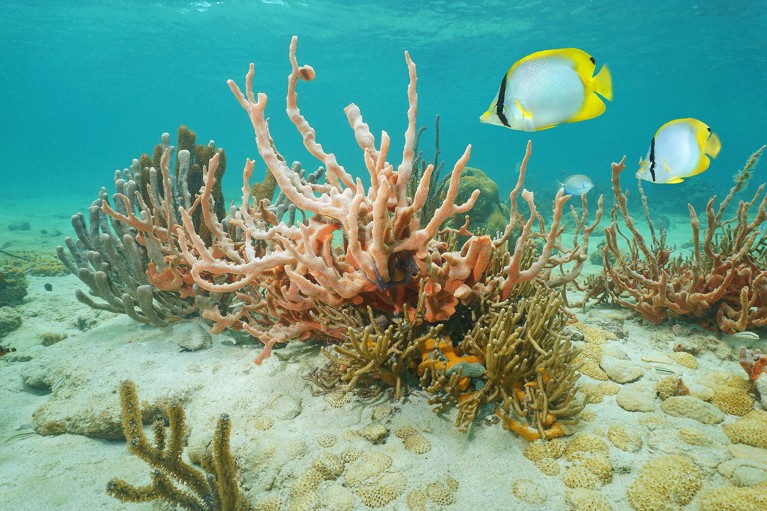Hello Nature readers, would you like to get this Briefing in your inbox free every day? Sign up here

Sea sponges (shown here with corals) have yielded molecules that inspire treatments for COVID-19 and other diseases.Credit: Seaphotoart/Alamy
After two decades of talks and a marathon 38-hour final session of negotiations, United Nations member countries have agreed on a framework to protect marine biodiversity and provide oversight of international waters. The High Seas Treaty will cover waters outside countries’ national jurisdictions, which extends 370 kilometres from their shores. These waters account for more than 70% of Earth’s surface. The treaty establishes a mechanism to designate marine protected areas and creates several groups — including a scientific and technical body — to oversee regulations covering issues including marine genetic resources. “We’re ecstatic,” says Kristina Gjerde, who researches marine environmental law. “This long-awaited treaty contains many of the vital things we need to safeguard our oceans.”
Nature | 5 min read
What has been the most successful and productive global geosciences collaboration for decades will come to a stark end next year. The US National Science Foundation (NSF) will retire its ocean-drilling vessel JOIDES Resolution, which has contributed to discoveries such as plate tectonics. “We’re losing a Hubble-telescope-type capability that we had for five decades,” says marine geologist Anthony Koppers. Researchers are asking the NSF to extend the JOIDES Resolution’s operations until 2028 to avoid a decade-long gap until a new ship is built. The NSF cited the US$72 million annual running cost as the reason for retiring the 44-year-old vessel.
Nature | 5 min read
The number of type 2 diabetes cases worldwide grew by more than 1.5% annually between 2000 and 2019. And in 2019, obesity and high blood cholesterol levels killed 5 million and 4.3 million people, respectively. Many people are eating more high-sugar, processed foods and doing less exercise, which might be partially responsible. Income inequality exacerbates the burden of these metabolic diseases, with people in low- to middle-income countries bearing the brunt. Some researchers warn that it’s more difficult to estimate death rates than this study makes it seem: people often die of cardiovascular or renal diseases instead of metabolic diseases per se.
Nature | 4 min read
Reference: Cell Metabolism paper
Features & opinion
Table of Contents
Bars, gyms and other indoor venues in Belgium will soon be required by law to meet air-quality targets and display real-time measurements of carbon dioxide concentrations — a proxy for how much clean air is piped in. It’s just one of an unprecedented number of efforts worldwide to make indoor air safer. Huge challenges lie ahead — retrofitting existing buildings will be an immense, costly undertaking. But countries are set to save billions by reducing the harmful effects of carbon monoxide, mould spores, cancer-causing fumes, particulates and respiratory pathogens.
Nature | 12 min read
Read more: We need a proper science of indoor air, write scientists including Christopher Whitty, the UK government’s chief medical adviser (Nature | 11 min read)
“ChatGPT has no model of what it is talking about. You’re watching a puppet show and believing the puppets are alive,” says François Chollet, an artificial-intelligence (AI) researcher at Google. Researchers want to change that. By increasing the number of connections between systems’ artificial neurons and feeding them ever more data, AI could eventually solve tasks that are supposed to require reasoning. Other scientists think this ‘bigger is better’ approach will only suck up more electricity. They hope that mimicking aspects of the brain, such as feedback connections and firing neurons, will help AI to become smaller and more energy-efficient — and maybe even give it the ability to reason.
Nature | 14 min read
Flash floods are a growing threat in some of the world’s driest regions. Last year, for example, around two-thirds of Pakistan was affected by widespread flash flooding, with more than 1,500 people killed and around 33 million made homeless. Meanwhile, more people are living in drylands, and arid regions are expanding because of climate change. A group of scientists set out six research priorities to address the risks, including data collection, early-warning systems and flood protection.
Nature | 10 min read
Today I’m saving up for two new Barbies: one celebrating the achievements of vaccinologist Sarah Gilbert, who co-developed the Oxford–AstraZeneca COVID-19 vaccine, and one of UK astronomy icon Maggie Aderin-Pocock. You could also choose Barbies based on Canadian physician Chika Stacy Oriuwa, Brazilian biomedical researcher Jaqueline Góes de Jesus, US doctor Audrey Sue Cruz, US emergency-room nurse Amy O’Sullivan and Australian MD and protective-gown developer Kirby White.
While I set up Barbie’s dream biosafety-level-4 laboratory in an old shoebox, why not tell me about the women who inspire you — plus any other feedback on this newsletter — at briefing@nature.com.
Thanks for reading,
Flora Graham, senior editor, Nature Briefing
With contributions by Katrina Krämer
We’ve recently launched two new e-mails you might like. They’re free, and of course you can unsubscribe at any time.
• Nature Briefing: Cancer — a new weekly newsletter written with cancer researchers in mind. Sign up here to receive the next one.
• Nature Briefing: Translational Research covers biotechnology, drug discovery and pharma. Sign up here to get it free in your inbox each week.
